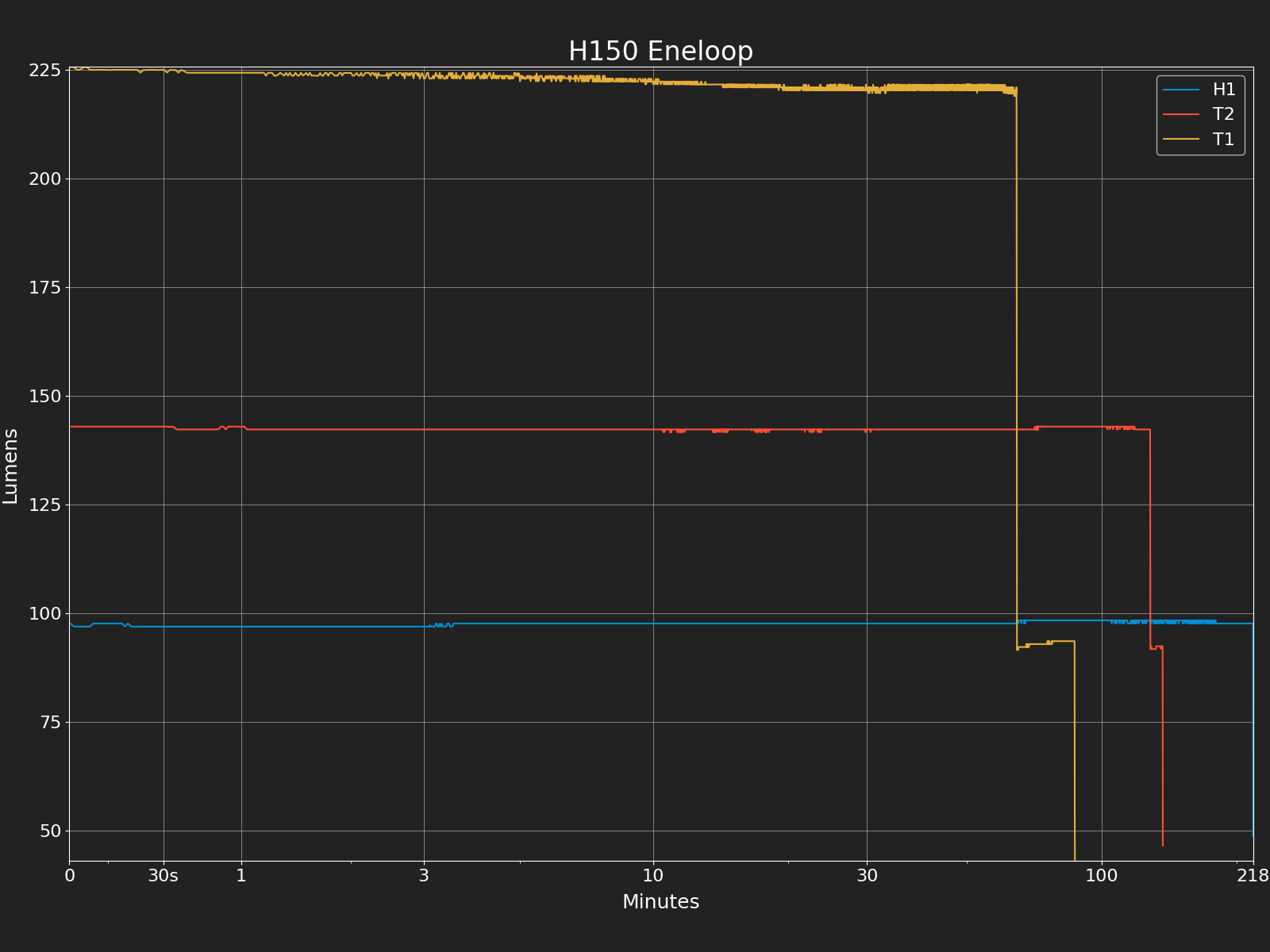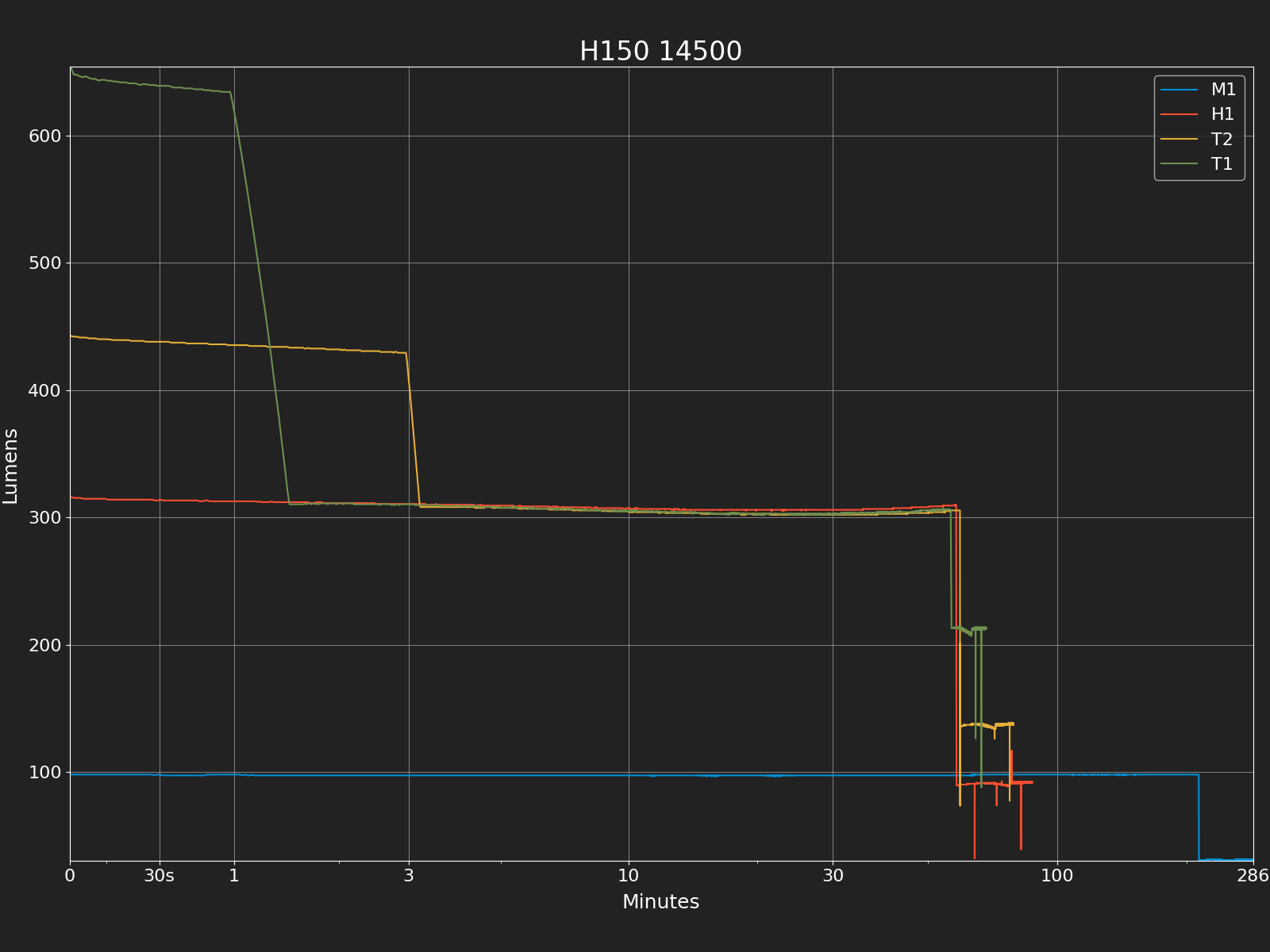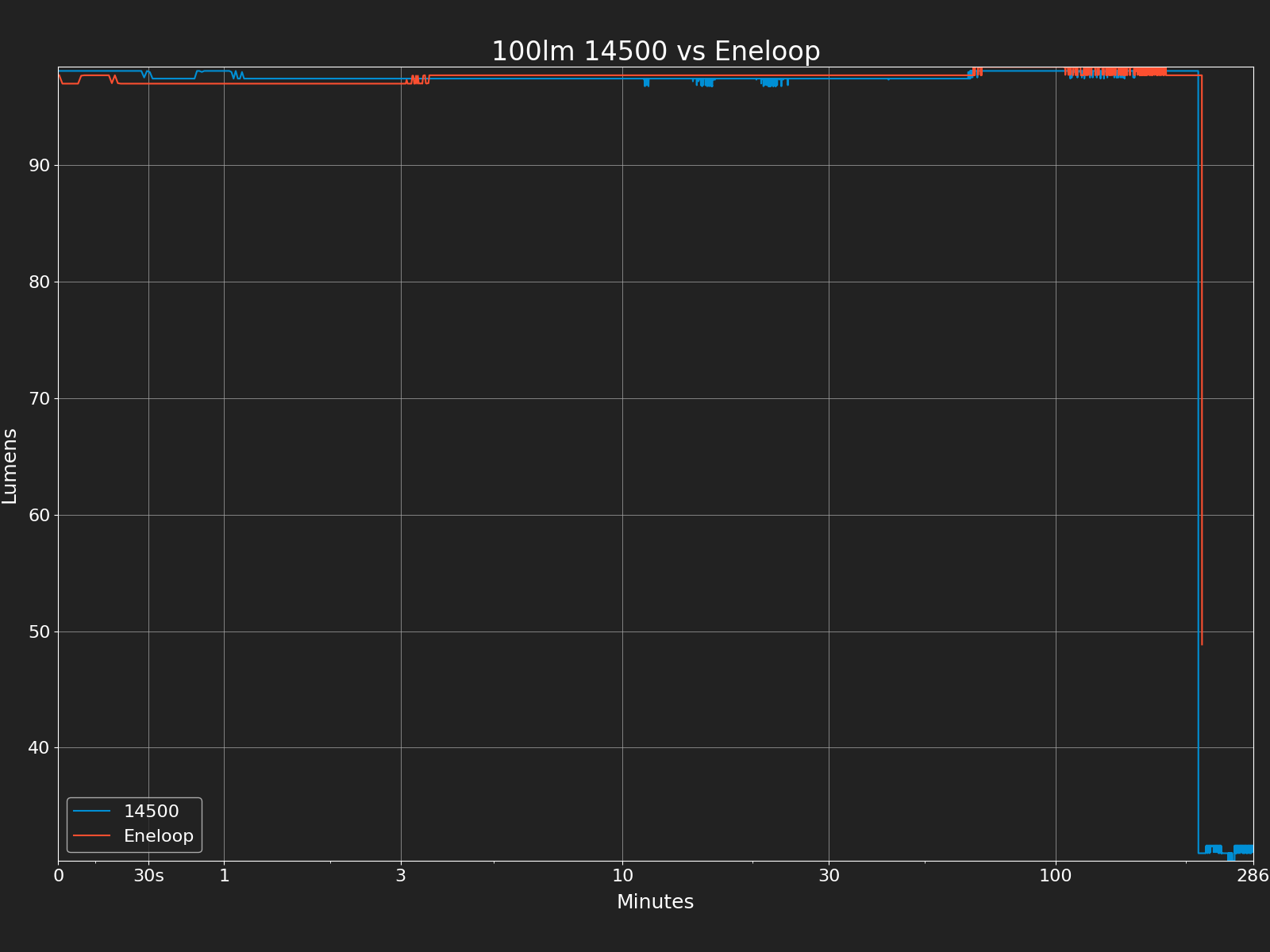This Skilhunt H150 (affiliate link) was provided by Skilhunt for review.
Overview
For most of my time writing flashlight recommendation guides, small headlamps were a difficult category. The headlamps popular in outdoor-oriented retail stores were usually terrible, with multiple AAA batteries, minimal water resistance, and output that drops rapidly to a tiny fraction of advertised. Lately, many are even worse, having non-removable batteries. Sometimes quality flashlight manufacturers would make an attempt, but even those usually fell short of their potential; the industry took its time learning to make lights that worked well with both ubiquitous AA batteries and higher-performing Li-ion 14500s.
When I reviewed the Skilhunt M150 flashlight, one of my first thoughts was that they should make a right-angle/headlamp version. The H150 is just that: a small right-angle headlamp with (optional) excellent color quality in neutral or warm white. It's powered by an AA or 14500 Li-ion battery and has onboard magnetic charging. The beam shape has been adjusted widened and diffused with a different optic, which better matches how most people use headlamps.
The Skilhunt H150 offers IPX8 (submersible) waterproofing, metal construction, stable output as the battery drains in medium and low modes, built-in charging, reasonable efficiency, great color quality, a lowest mode under 1 lumen to preserve dark adaptation, a magnetic tailcap for use as a work light, and the versatility of both common AA and powerful 14500 batteries. Some may prefer a more standard USB port for charging, but the magnetic pad does offer advantages in waterproofing, and it's very quick to attach.
My only serious complaint is that the magnetic charging pad can make a spark when short-circuited, making the H150 ill-suited to environments with metal shavings.
While otherwise outstanding, the potential to make a spark is a serious flaw and I have to reduce its rating for that. The H150 is recommended.
Specifications
| Spec | - |
|---|---|
| Battery | 1x14500, 1xAA |
| LED | Nichia 519A (Cree XP-L2 optional) |
| Color temperature | 4993K |
| Color rendering index | 96 |
| Max output | 639lm |
| Max throw | 78m |
| Max sustainable output | 314lm |
| Max output at 50% battery | 639lm |
| Best efficiency | 160 lm/W [1] |
| Candela per lumen | 2.4 (floody) |
| Length | 79.8mm |
| Head diameter | 21.4mm |
| Weight | 39g |
| Weight with battery | 59g |
| Weight with battery and headband | 98g |
| Charging | USB-A to magnetic pad |
| Low Voltage Protection (LVP) | Yes |
| Lockout | Mechanical and electronic |
| Approximate price | $49 |
| Rating | ★★★★☆ (recommended) |
- H1 with NiMH battery, 97 lumens. Only measurements taken from a full runtime record are counted.
Highlights
- Excellent color rendering and neutral tint
- Stable output
- Compatible with all AA and 14500 batteries
- Good sub-lumen low mode for preserving dark adaptation
- Comfortable headband
Lowlights
- Magnetic charging pad can spark when shorted
- Efficiency with Li-ion could be better
- May attempt to charge non-rechargeable batteries
Details and technical analysis
Versions
The H150 is available with a choice of Nichia 519A with a high color rendering index or Cree XP-L2 LEDs with a little more output. The 519A offers a choice between a 4500K color temperature, which looks like afternoon sunlight, and 3000K, which looks like an incandescent bulb. The XP-L2 is cool (blue) white. A choice of black, grey, green, or orange anodizing is offered.
This is the grey, 519A, 4500K version.
Accessories
The H150 comes with a headband, pocket clip, magnetic charging cable, lanyard, spare O-rings, and 14500 battery. An 800 mAh battery in included by default; a 1050 mAh battery with USB-C charge port is offered for an additional $3 at publication time.
Modes and user interface
User Interface
3C means to press and release the button three times in rapid succession. 3H means to press and release twice, then press and hold. Memory means that the last-used mode in the group is activated.
| State | Action | Result |
|---|---|---|
| Off | Hold | Low group (memory) |
| Off | Click | Medium group (memory) |
| Off, low, medium | 2C | Turbo group (memory) |
| Turbo | 2C | Medium group (memory) |
| Low, medium, turbo | Hold | Adjust brightness |
| Any | 3C | Strobe group |
| Off | 4C | Lockout |
| Lockout | 4C | Low group (memory) |
| Lockout | Hold | L1 (momentary) |
| Low | 2H | Medium group (memory) |
| Medium | 2H | Low group (memory) |
| Strobe | 2C | Cycle strobe, SOS, beacon |
Slightly loosening the tailcap disconnects the battery locks out the light mechanically.
Modes
| Mode | Estimated lumens | Estimated throw (FL1 meters) |
|---|---|---|
| M2 | 17 | 11 |
| M1 | 98 | 30 |
| H1 | 314 | 55 |
| T2 | 438 | 65 |
| T1 | 639 | 78 |
Output, runtime, and efficiency
NiMH AA battery
Tests were performed using a Panasonic Eneloop 1900 mAh NiMH battery. This battery has less capacity than the 2450 mAh battery used for the H150's advertised runtimes. Efficiency for M1 and lower modes is only a rough estimate.
| Mode | Estimated lumens |
Time to 80% | Time to 50% | Time to 10% | Efficiency (lm/W) |
Current (mA) |
|---|---|---|---|---|---|---|
| L2 | 0 | 2.7 months | - | 1 | ||
| L1 | 3 | 4.2 days | 132 | 19 | ||
| M2 | 9 | 1.6 days | 150 | 50 | ||
| M1 | 32 | 12.1 hours | 170 | 157 | ||
| H1 | 97 | 3.6 hours | 3.6 hours | 4.0 hours | 160 | 457 |
| T2 | 143 | 2.1 hours | 2.3 hours | 2.4 hours | 144 | 730 |
| T1 | 225 | 65 minutes | 65 minutes | 92 minutes | 127 | 1340 |

Li-ion 14500 battery
Tests were performed using a Vapcell H10 1000 mAh Li-ion battery. Due to age and wear, the test battery has a capacity of 797 mAh, effectively the same as the 800 mAh battery used for the H150's advertised runtimes. Efficiency for M2 and lower modes is only a rough estimate.
| Mode | Estimated lumens |
Time to 80% | Time to 50% | Time to 10% | Efficiency (lm/W) |
Current (mA) |
|---|---|---|---|---|---|---|
| L2 | 0 | 1.1 months | - | 1 | ||
| L1 | 3 | 4.2 days | 101 | 8 | ||
| M2 | 17 | 19.9 hours | 115 | 40 | ||
| M1 | 98 | 3.6 hours | 3.6 hours | 5.0 hours | 131 | 204 |
| H1 | 314 | 58 minutes | 58 minutes | 88 minutes | 116 | 722 |
| T2 | 438 | 3.1 minutes | 59 minutes | 82 minutes | 119 | 1048 |
| T1 | 639 | 1.2 minutes | 1.5 minutes | 73 minutes | 114 | 1650 |

Efficiency with Li-ion is not as good with Li-ion as it is with NiMH. A bit more testing reveals why; when battery voltage is less than required to run an LED, as is always true with a single 1.2 or 1.5V battery powering a white LED, the flashlight's driver must convert it to a higher voltage, which is usually reasonably efficient. This is called a boost driver. If, however, battery voltage exceeds what's required to power an LED, a flashlight driver can either turn the excess into heat (a linear driver), or efficiently convert it to a lower voltage (a buck driver). The Li-ion battery's voltage does, indeed exceed what the LED requires.
Skilhunt's larger Li-ion-only lights use either buck or boost drivers depending on what LED they have, but the H150 operates as a boost driver with an AA battery and a linear driver with a 14500 battery. Testing both batteries at their respective ~100 lumen modes, the Eneloop, with a capacity of 2.3 Wh maintains 100 lumens longer than the H10 with a tested capacity of 2.9 Wh. I would like to see a more efficient boost/buck driver in a future version of this light.

Light quality
The color rendering of the H150 with the Nichia 519A LED is among the best I've seen. Good color rendering makes it easier to tell a stick from a snake while hiking, distinguish different fluids while repairing a car, and see detail in general.
Readings are taken from the center spot using an X-rite i1Pro spectrophotometer.
NiMH AA battery
| Mode | Color Temperature |
Tint Duv | CRI | CRI R9 (deep red) |
CRI R12 (deep blue) |
|---|---|---|---|---|---|
| L2 | 4608K | 0.0007 (neutral) | 96.3 | 98.5 | 77.0 |
| L1 | 4873K | -0.0001 (neutral) | 96.8 | 92.9 | 78.6 |
| M2 | 4670K | 0.0003 (neutral) | 96.6 | 97.8 | 75.7 |
| M1 | 4626K | 0.0002 (neutral) | 96.5 | 98.4 | 76.0 |
| H1 | 4706K | 0.0000 (neutral) | 96.2 | 99.5 | 76.1 |
| T2 | 4733K | -0.0001 (neutral) | 96.0 | 99.2 | 76.2 |
| T1 | 4762K | -0.0004 (neutral) | 95.7 | 98.2 | 76.6 |
Li-ion 14500 battery
| Mode | Color Temperature |
Tint Duv | CRI | CRI R9 (deep red) |
CRI R12 (deep blue) |
|---|---|---|---|---|---|
| L2 | 5032K | 0.0006 (neutral) | 96.3 | 99.2 | 80.6 |
| L1 | 5000K | 0.0011 (slightly green) | 96.3 | 99.5 | 80.6 |
| M2 | 5068K | -0.0001 (neutral) | 96.4 | 97.3 | 81.1 |
| M1 | 4710K | -0.0005 (neutral) | 96.5 | 98.9 | 76.2 |
| H1 | 4962K | -0.0006 (neutral) | 95.2 | 97.2 | 77.1 |
| T2 | 4830K | -0.0016 (slightly rosy) | 95.5 | 96.6 | 77.4 |
| T1 | 4794K | -0.0022 (slightly rosy) | 95.0 | 94.4 | 78.3 |
I noticed my early, recalled H150 looked a little warmer than this sample, so I measured it.
| Mode | Color Temperature |
Tint Duv | CRI | CRI R9 (deep red) |
CRI R12 (deep blue) |
|---|---|---|---|---|---|
| M1 | 4466K | 0.0002 (neutral) | 95.8 | 99.5 | 78.0 |
Beamshots
I use the Zebralight SC64c LE as my standard point of reference in beamshots. It is larger and more expensive than the H150, and not a headlamp, so its inclusion is not intended as a competitive comparison.
Maximum, sustainable, Zebralight SC64c
Tint versus BLF 348 (right)
Tint versus Zebralight SC64c LE (right)
Tint comparison between two H150s, showing there may be slight variations
Batteries and charging
The H150 can use any 14500 Li-ion battery in my inventory, including both protected and unprotected cells, flat and button top, and cells with USB-C charging ports. Unprotected, flat-top cells can move enough to turn the light off if vigorously shaken or from a firm impact on the tailcap. Any AA battery works as well, from NiMH rechargeables to alkalines to shelf-stable disposable lithium. Alkalines, of course have poor capacity in higher modes.
The included MC10 USB-to-magnetic charging cable charges a 14500 battery at up to 1 Amp, tapering off toward the end. The identical-looking MC20 cable from larger Skilhunt models will also charge a 14500 in the H150, but at 2A, which is too much and has the potential to shorten the service life of a 14500. A light in the charging cable turns red during charging, and blue when charging is complete.
The manual says the onboard charging function is only for 14500 Li-ion batteries. I briefly connected the cable with a NiMH AA battery installed, and the light turned red. I measured 150 mA between the body and the battery, indicating that it does attempt to charge the battery, but at low current. I recommend caution, as this might damage the battery or headlamp.
The charging cable can power the H150 without a battery installed or during charging.
Construction
Flashlight enthusiasts usually expect all-metal construction, and the H150 provides it, giving it an advantage in durability over many of the camping store brands' plastic bodies. The TIR optic is the only plastic here, and it isn't covered by a glass lens. I'd normally consider that cause for complaint because the optic can be scratched, but that isn't a problem with this textured design. The machining and finish are of good quality, the threads turn smoothly, and the waterproofing appears to perform as advertised.
Size and ergonomics
The H150 is small, not much larger than the battery that powers it. It's noticeably lighter than any of my headlamps powered by 18650 batteries, making it comfortable for me to wear the headband without the included top strap. It's comfortable to carry as a pocket light with the included clip, and can be installed in the headband without removing the clip. The side button is easy to find by feel in both handheld and headlamp use.
The mount can rotate, and is compatible with MOLLE so it works well on compatible backpack straps and clothing.
Modification potential
People with experience reflowing LEDs should have no trouble swapping in another 3535 size, 3-volt LED. It's also likely other optics could be made to work.



















Comments
You can use your Mastodon or Lemmy account to reply to this
Reply Reply
Reply
Loading...